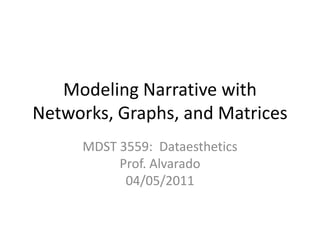
Mdst 3559-04-05-networks-and-graphs
- 1. Modeling Narrative with Networks, Graphs, and Matrices MDST 3559: DataestheticsProf. Alvarado04/05/2011
- 2. Business Problems with some comments being classified as spam Permissions for posting have been reset … Final projects to be announced next Tuesday Optional readings posted … see blog
- 3. Review Text vs. Image Views of Rustam Implicit structures
- 4. Text vs. Image The Images show that Zimmern’s translation is flawed
- 5. Views of Rustam Compassionate but badass Hero; Batman Somewhere between King and peasant “He needs God to be with him, so he doesn’t appear to be a religious figure.” (?) Fears nothing Resourceful Part human, part animal Arrogant Quick-witted Chivalric Hero A Prince (?) “he had not of his own choice chosen this adventure” Bound by Destiny Agency is might His sword is badass, it “cleaves / Not the armour of jousting knights, / But the skulls of dragons and Deevs.”
- 6. Rustamas Liminal Hero SON OF RUSTAM AGENT OF SUB FOR
- 7. Structure? Rustam= PowerPuff Girls Kai Kaus = Mayor Zal = Father (kind of) King of M = Mojo Jojo White Deev = One of MJ's minions Lions, etc. = Fuzzy Lumpkins?
- 8. Structure Frodo = Dorothy Ring = Slippers Sam = Tin Man, etc. Gandalf = Good Witch Sauron = Bad Witch Gollum = Toto -> mediator
- 9. Structure
- 11. Structuralist “Prosopography” Recurring patterns and structures imply cultural models Political Organization KING / COUNCILLOR (PRIEST) / WARRIOR Nature of Power Royal Power is fragile and dependent Now, How to Describe and Represent?
- 13. Overview Discuss Ramsay, “In Praise of Pattern,” to explore ways of modeling and visualizing narrative Look at some other examples Discuss graphablepatterns in the Shahnameh, in preparation for hands-on work Thursday
- 14. In Praise of Pattern Ramsay argues that, in addition to the quantitative theorems of graph theory, graphs make good visualizations They help you notice things, patterns See version with images http://studio1.shanti.virginia.edu/~rca2t/dataesthetics/04-05/ramsay-2005.html
- 15. Graph Theory The Geometry of Posistion (actually coined by Leibniz) Reduces things to “vertices” and “edges” Or “nodes” and “links” (dots and lines) Theorems concern features such number of nodes number of edges number of edges per node “degrees” of separation between nodes, etc.
- 16. Euler’s Solution to the Seven Bridges Problem 3 It becomes clear that nodes with with odd numbered links are a problem – if you come back to it, and aren’t finished, you are stuck … Vizualized in this way, the problem becomes one of drawing the picture without retracing any line and without picking up the pencil. 3 5 3 http://mathforum.org/isaac/problems/bridges2.html
- 17. Shaded Similarity Matrices “You take a set of data measurements for a set of classes and use it to create another table that expresses degrees of proximity among those measurements. . . “You then reorganize those values so that “more similar” values are adjacent to one another, assign each value a color, and arrange them in a grid.”
- 19. Ramsay’s Application Correlate graph properties with genre for plays 5 properties: Distinct, Total, Singles, Loops, and Switches 4 genres: Romance, Tragedy, History, and Comedy “Low-level” vs. “high-level” properties Method X and Y axes both show plays, colored by genre Each cell in the matrix is shaded according to similarity in terms of low-level properties Low-level properties are added successively and the order of plays is changed to find clustering
- 24. PROTOVIS “Adjacency matrix” of characters in Les Misérables http://vis.stanford.edu/protovis/ex/matrix.html
- 27. The Charrette Project A database of manuscripts, the critical edition, and poetic and grammatical data associated with Chrétien de Troyes's Le Chevalier de la Charrette (Lancelot, ca. 1180) Home page: http://www.princeton.edu/~lancelot/ss/index.shtml Interactive database: http://gravitas.princeton.edu/charrette/figura/index.php
- 31. Patterns in the Shahnameh Characteristic events (event types) and sequences E.g. drinking wine Implied social networks Next week, we will look at these patterns and explore tools to visualize them
Hinweis der Redaktion
- Data Source: Louisa Co. Burnley Slave ListsApplication: GephiLayout algorithm: Dual CircleContent: Slaves, Owners, and PurchasersNotes: This shows the graph at a zoomed out level, where clusterings can be seen, but no specific data points. The four central densely linked nodes are slave owners or purchasers.
- Data Source: Louisa Co. Burnley Slave ListsApplication: GephiLayout algorithm: Dual CircleContent: Slaves, Owners, and PurchasersNotes: This shows the same graph as the previous slide but zoomed in to show details of data points.